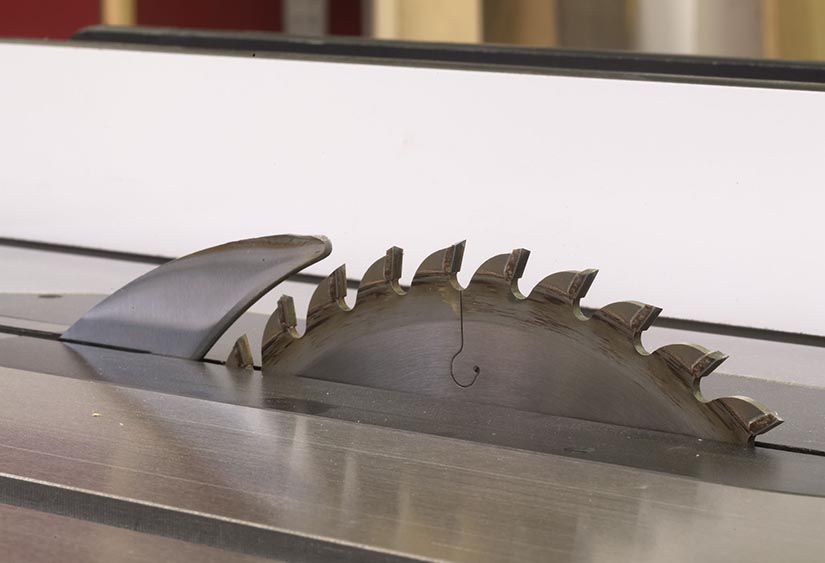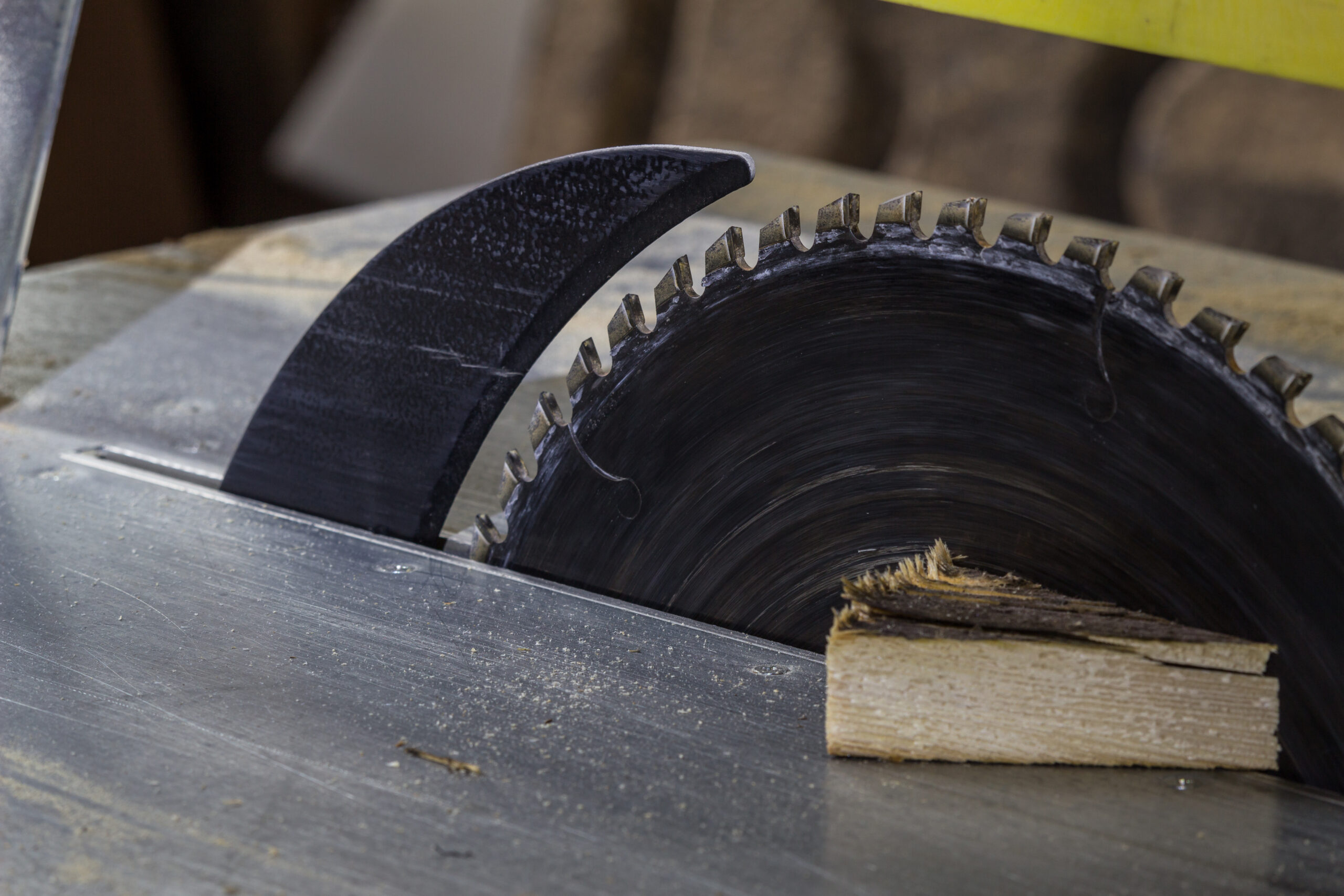Table saws are a popular tool among woodworkers, but have you ever wondered if all table saws come with riving knives? Well, in this article, we’ll explore the ins and outs of riving knives and whether they are a standard feature on all table saws.
So, what exactly is a riving knife? Imagine a sharp, thin piece of metal that sits behind the saw blade, rising and falling with it. Its purpose? To prevent kickback, those scary moments when a piece of wood is thrown fiercely back at the operator. Sounds pretty important, right?
Now, you might be thinking, “Do all table saws have riving knives?” Stick around as we dive into the world of table saws to find out. It’s time to unravel the mystery and equip you with the knowledge you need for safe woodworking. Let’s get started!
When it comes to table saws, not all models have riving knives. Riving knives are an important safety feature that helps prevent kickback and keeps the workpiece stable. While many modern table saws do come with riving knives, it’s always a good idea to check the specific model’s specifications before purchasing. Riving knives enhance the safety and precision of the table saw, making them a desirable feature for woodworkers of all skill levels.

Do All Table Saws Have Riving Knives?
Table saws are a vital tool in any woodworking shop, providing precision cuts and versatility for a wide range of projects. One important feature to consider when purchasing a table saw is whether or not it is equipped with a riving knife. A riving knife is a safety device that helps prevent kickback and keeps the wood from pinching the saw blade, reducing the chance of accidents and ensuring smoother cuts. In this article, we will explore the topic of riving knives in table saws, including their purpose, benefits, and whether or not all table saws have them.
The Purpose of Riving Knives
Before diving into the topic of whether all table saws have riving knives, it is essential to understand their purpose and how they enhance safety. A riving knife is a thin, metal plate positioned just behind the saw blade. Its primary function is to prevent kickback, which occurs when the workpiece gets caught on the back of the blade, causing it to launch back towards the operator.
Riving knives work by closely following the movements of the blade. Unlike a splitter, which is a stationary device that does not adjust with blade height and angle changes, a riving knife moves up and down along with the blade. This ensures that the distance between the riving knife and the blade remains consistent, regardless of the cutting depth or angle. By keeping the wood separated and preventing it from closing in on the back of the blade, riving knives significantly reduce the risk of kickback.
Additionally, riving knives also help prevent the wood from pinching the blade, which can lead to burning, binding, or rough cuts. By creating a gap between the two sides of the cut, riving knives allow for smoother, more precise cuts, improving the overall quality of the finished piece.
Types of Table Saws and Riving Knives
While riving knives are an essential safety feature in modern table saws, it’s essential to note that not all table saws come with riving knives as a standard feature. Different types of table saws may have varying safety mechanisms and blade guards in place.
Benchtop Table Saws:
Benchtop table saws are compact and portable, making them a popular choice for small woodworking shops or jobsites. While they offer convenience and ease of use, many benchtop table saws may not come with a built-in riving knife. However, it is possible to purchase aftermarket riving knives or splitters that can be retrofitted onto these saws for added safety.
Contractor Table Saws:
Contractor table saws are larger and more powerful than benchtop models, commonly used by professional contractors and serious hobbyists. Most contractor table saws are equipped with riving knives as a standard feature, providing an added layer of safety during cutting operations.
Cabinet Table Saws:
Cabinet table saws are heavy-duty machines designed for professional woodworkers and heavy production work. These high-end saws often come with advanced safety features, including riving knives. Cabinet table saws prioritize safety and precision, making them an ideal choice for woodworking shops that require consistent, high-quality cuts.
Hybrid Table Saws:
Hybrid table saws are a cross between a contractor table saw and a cabinet table saw. They offer the power and performance of a cabinet saw but with a smaller footprint and a more affordable price tag. While some hybrid table saws may come with riving knives, others may require the purchase of an additional accessory.
Portable Table Saws:
Portable table saws are designed for jobsites and on-the-go woodworking. Due to their compact size and lightweight design, they may not include riving knives as a standard feature. However, some portable table saws may offer the option to attach an aftermarket riving knife or splitter.
Riving Knives vs. Splitters
While riving knives are highly recommended for table saw safety, some older table saws may be equipped with splitters instead. Splitters serve a similar purpose as riving knives, creating a gap between the wood and the blade to prevent kickback. However, splitters are often fixed in place and do not adjust with blade height or angle changes. This lack of adjustability can limit the versatility and safety provided by riving knives.
Riving knives are generally considered superior to splitters as they provide better protection against accidents and allow for more precise cuts. When purchasing a table saw, it is advisable to opt for one with a riving knife, or at the very least, ensure that the table saw is compatible with aftermarket riving knives or splitters.
Benefits of Using a Table Saw with a Riving Knife
Using a table saw with a riving knife offers several benefits, including:
- Enhanced safety: Riving knives significantly reduce the risk of kickback, protecting the operator from injuries.
- Cleaner cuts: By preventing the wood from pinching the blade, riving knives contribute to smoother, cleaner cuts.
- Improved accuracy: Riving knives help maintain consistent distance between the blade and the wood, resulting in more precise cuts.
- Reduced tear-out: When the wood does not bind or pinch, tear-out and splintering are minimized, leading to better-quality finished pieces.
- Versatility: Adjustable riving knives accommodate various cutting depths and angles, allowing for a wider range of woodworking projects.
Conclusion
While not all table saws come with riving knives as a standard feature, it is highly recommended to use a table saw equipped with a riving knife for increased safety and improved cutting quality. Riving knives help prevent kickback, reduce the risk of accidents, and create cleaner, more precise cuts. When choosing a table saw, consider the type of saw, as different models may offer varying safety features. Remember that aftermarket riving knives or splitters can often be purchased for saws that do not come with them as a standard feature. Prioritizing safety and investing in equipment that provides the necessary safeguards will lead to a more enjoyable and productive woodworking experience.
Key Takeaways: Do All Table Saws Have Riving Knives?
- Not all table saws come with riving knives.
- Riving knives are important safety features that help prevent kickback.
- Table saws without riving knives may have other safety features in place.
- It is recommended to choose a table saw with a riving knife for added safety.
- Always follow the manufacturer’s instructions and safety guidelines when operating a table saw.
Frequently Asked Questions
Are you curious about riving knives on table saws? Here are some common questions answered.
1. How does a riving knife on a table saw work?
A riving knife is a safety device that sits behind the saw blade and moves up and down with it. Its purpose is to prevent kickback by keeping the wood from pinching the blade, reducing the risk of the wood being propelled towards the user. When the blade is tilted, the riving knife also tilts to maintain its position relative to the blade.
Riving knives are particularly effective at minimizing kickback when cutting through thicker stock or hardwoods. They provide an additional layer of protection and are widely regarded as a crucial safety feature on modern table saws.
2. Are riving knives only found on certain table saw models?
No, not all table saws come equipped with riving knives, but many modern models do. In recent years, there has been a growing understanding of the safety benefits provided by riving knives, leading to their inclusion in a wide range of table saws. However, it’s worth noting that some older or more basic models might not have this feature.
If you are in the market for a new table saw, it is highly recommended to choose a model that includes a riving knife for enhanced safety. Always check the product specifications or consult with a salesperson to ensure the table saw you’re considering comes with this important safety feature.
3. Can I add a riving knife to a table saw that doesn’t have one?
In some cases, it may be possible to retrofit a riving knife onto a table saw that does not come with one originally. However, this is not a straightforward task and should only be attempted by experienced individuals with knowledge of table saw mechanics.
It’s important to bear in mind that retrofitting a riving knife may void the warranty of the table saw and may not be a practical or cost-effective solution when compared to purchasing a new table saw with a built-in riving knife. Always consult with a professional or manufacturer for guidance on retrofitting safety features.
4. Are there any alternatives to a riving knife?
While a riving knife is highly recommended for table saw safety, there are alternative devices that offer some level of kickback prevention. Splitter inserts, for example, can be installed in the same slot as the saw blade and serve a similar purpose to riving knives, although they may not be as effective in preventing kickback in certain situations.
Another alternative is a featherboard, which is a flexible device used to hold the wood against the fence and prevent it from lifting during the cut. While not specifically designed for kickback prevention, featherboards can provide additional stability and reduce the chances of a dangerous kickback incident.
5. Are there any safety precautions to follow when using a table saw without a riving knife?
If you find yourself using a table saw without a riving knife, it’s essential to follow other safety guidelines to minimize the risk of kickback. Ensure you properly set up the table saw, including adjusting the blade height and fence alignment. Always wear appropriate safety equipment, such as safety glasses, and use a push stick or push block to keep your hands away from the blade. Lastly, be vigilant and maintain full attention while operating the saw to prevent accidents.
However, it is strongly recommended to select a table saw with a built-in riving knife or consider retrofitting one for enhanced safety. The riving knife is a purpose-built safety device that significantly reduces the risk of kickback and is an invaluable feature for any table saw user.

Summary
Table saws are powerful tools used for woodworking, but not all of them have riving knives. A riving knife is a safety feature that helps prevent kickback by keeping the wood from pinching the blade. It is important for safety, especially for beginners.
Some table saws come with riving knives built-in, while others do not. If you have a table saw without a riving knife, it is recommended to add one for safety reasons. Riving knives can be purchased separately and easily installed on most table saws. Always follow safety guidelines and use proper precautions when operating a table saw.
